Articles
The Islamic collections of the Museum of Santa Cruz in Toledo
Article author: Sergio Isabel Ludeña - Center for the Center for the Study of Islamic Toledo
Date of publication of the article: 30/11/2023
Year of publication: 2023
Article theme: Al-Andalus, Archaeology, Art, History, Toledo.
Summary
Although part of the cultural heritage has a monumental character, sometimes it is the smaller movable pieces that provide us with more information to understand the life and mentalities of the societies of the past. In the case of Castilla-La Mancha, the Museum of Santa Cruz, together with its subsidiaries, such as the Taller del Moro, serves as a provincial archaeological museum and houses numerous objects from the Andalusian world and its Islamic continuities. It is these elements, transferred from their original places and kept in the museums, that will allow us to approach different aspects of Toledo’s medieval society.
Introduction
During the months of October, November and December, the Center for Studies on Islamic Toledo (Islamic Culture Foundation) has promoted a series of free visits so that citizens can approach different topics about Tulaytula, the Andalusian Toledo. As scientific coordinator of the center -and archaeologist-, it seemed to me an excellent opportunity to propose in the program a tour of the Islamic collections deposited in the Museum of Santa Cruz and in one of its branches, the Taller del Moro.
The historical tour of the Museum of Santa Cruz, which serves as a provincial museum of archeology and fine arts, is extensive[1]. It was created as the Provincial Museum of Toledo in the mid-nineteenth century, moved to various parts of the city (the convent of San Pedro Mártir, the monastery of San Juan de los Reyes, the palace of the Diputación de Toledo and, finally, the hospital of Santa Cruz) and progressively expanded in space through several subsidiaries (the Taller del Moro and the Ruiz de Luna Museum, 1963; the House-Museum Dulcinea del Toboso, 1967; the Museum of the Councils and Visigothic Culture and the Palace-Museum of Fuensalida[2], 1971; and the Museum of Contemporary Art of Toledo[3], 1975). The already rich initial collections, from works of art from disentailed convents and the Cabinet of Antiquities of Cardinal Lorenzana, among other sources, grew – albeit with occasional losses, the result of assignments, loans and transfers to other museums – with the archaeological pieces that were found in Toledo and its province (Caballero Klink and Gómez García, 2017). The collections linked to archaeological sites have increased especially in recent decades, since Spanish legislation established that materials found in archaeological interventions must be deposited in provincial archaeological museums.
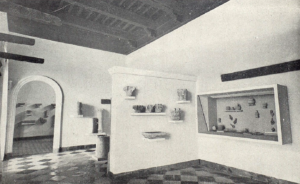
The museum’s collections include many pieces that have sometimes been categorised as ‘Mudéjar’ or ‘Mudéjar art’.
These circumstances indicate that the museum treasures an enormous amount of archaeological pieces with a chronology ranging from prehistoric times to the present. However, at present it is only possible to see a very small part of this collection because the permanent exhibition -the one dedicated to archaeology- has been dismantled. This, as a consequence, prevents citizens from being able to learn, in such an extraordinary way, the history of the city of Toledo and its province. Only a few archaeological elements are kept outside the warehouses, in the noble courtyard and the so-called “Mudejar Space” in the hospital of Santa Cruz and in some of the other venues (such as the Taller del Moro or the Museum of the Councils and Visigothic Culture). Despite this, the intention of both the guided tour and this article is to demonstrate, simply with a small selection of materials, the possibilities that recovering the permanent archaeological exhibition would offer to society.
Brief historical notes: from the end of the Caliphate of Cordoba to the Christian conquest of Toledo
In the first decades of the 11th century, the caliphate of Cordoba suffered a crumbling of its structure as a result of a profound political crisis[4] of its structure as a result of a profound political crisis, known as the second fitna, and al-Andalus was fragmented into more than thirty different political units: the taifas. During practically the rest of the 11th century, these Andalusian states were to suffer notable political instability. Nevertheless, in the cultural field there was a period of splendor, in which a notable development of the sciences and the arts stood out (Martos Quesada, 2009: 149).
One of the most important and largest taifas was that of Toledo, which had its head in that city. Its antecedents can be found in one of the territorial and administrative demarcations existing in al-Andalus during the emirate and the caliphate, the Middle Mark, which extended around the middle valleys of the Tagus and Guadiana rivers. In the period from 1010 to around 1030 it seems that the city and its surrounding territory were governed by a council of notables, whose members belonged to the municipal elites[5]. The weakness of this government is quite probable, since Toledo never minted money during these years and, in addition, the political and administrative instability must have led to its end. Thus, after a series of internal struggles, the Toledans offered power to ‘Abd al-Raḥmān bin Di-l-Nun, lord of Santaver, in whose hands an important military force, typical of the frontier lineages, was to be kept (Viguera Molins, 1999: 55-56). It was at this time that this dynasty came into contact with Tulaytula, whose taifa it would head until 1085, when the Christian conquest by Alfonso VI took place.
The Banu Di-l-Nun were a family of Amazigh origin, from the Hawwara tribe, but who had arrived in the Iberian Peninsula with Tariq b. Ziyad. However, their original name of Zennun was changed to the Arabic Di-l-Nun in order to establish a link with important Yemeni families and ennoble themselves (Izquierdo Benito, 2018: 417). His ancestors had settled in the cora of Santaver, where with the passage of time the lineage gained strength. During the caliphal period they already showed signs of their vitality by controlling Huélamo, Uclés and Huete. During the second fitna, the Banu Di-l-Nun took steps to increase their dominions by taking over Cuenca. Later, after the offer of the Toledans, ‘Abd al-Raḥmān bin Di-l-Nun sent his son Isma’il to rule them (Viguera Molins, 1999: 57).
Three were the kings of this family who occupied the taifa throne: Isma’il bin Di-l-Nun “al-Zafir” (c. 1030-1043), Yaḥya ibn Isma’il “al-Ma’mun” (1043-1075) and Yaḥya ibn Isma’il ibn Yaḥya “al-Qadir” (1075-1085). The first secured the foundations of the kingdom and the dynasty, the second consolidated the work of his father and reached the cultural peak -especially in astronomy and botany (Calvo Capilla, 2011: 69-73)- and political peak among the taifas -even managing to take over Valencia and Cordoba-. The third, on the other hand, grandson of the second, did not manage to overcome the instability of his time and decided to reach an agreement with Alfonso VI. The latter assured al-Qadir the taifa of Valencia in exchange for the surrender of Toledo. On May 25, after a few months of siege and capitulations with favorable conditions for its inhabitants, Alfonso VI entered Toledo and al-Qadir received Valencia, where he would be assassinated in 1092 (Delgado Valero, 1987: 43-45). Thus ended the Taifa and the Christian rule over the city began, with its incorporation into Castile, not without difficulties in the early days due to the conflict with Almoravids and Almohads.
Tulaytula through its material legacy: a summary of the Islamic pieces that can be visited at the Museum of Santa Cruz.
The Museum of Santa Cruz treasures in its collections multiple pieces that help us to understand some aspects of the Taifa of Toledo and its society. With regard to the works of aulic promotion, linked to the dynasty of the Banu Di-l-Nun, there are two well curbstones from mosques and several architectural decorative elements -such as the panel of the birds facing each other, capitals and bases- originating from palace complexes. Likewise, in the funerary world, the collections of the institution contain a large number of inscriptions in Arabic located on bricks, tombstones and cipher related to cemetery areas. However, most of them are in the storerooms and only one epitaph and four of these funerary columns are visible (in the noble courtyard of the hospital of Santa Cruz).
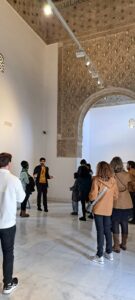 On the other hand, among the museum’s collections there are many pieces that have sometimes been categorized as “Mudejar” or “Mudejar art”. Although it is common to hear about this artistic style, it is debated by specialists today. Among those who have discredited the use of the term “Mudejar art”[6], I would especially like to highlight Juan Carlos Ruiz Souza, who several years ago argued that the long survival and expansion of Andalusian forms was the result of a cultural coexistence in many contexts of the Hispanic medieval world[7]. In fact, Islamic decorations and forms were loaded with symbolism and were admired by the Christians of the time, who did not hesitate to use Andalusian forms and decorations in their projects. It is for this reason that many of these continuations of Islamic culture -in spaces under Christian rule- require a re-reading.
On the other hand, among the museum’s collections there are many pieces that have sometimes been categorized as “Mudejar” or “Mudejar art”. Although it is common to hear about this artistic style, it is debated by specialists today. Among those who have discredited the use of the term “Mudejar art”[6], I would especially like to highlight Juan Carlos Ruiz Souza, who several years ago argued that the long survival and expansion of Andalusian forms was the result of a cultural coexistence in many contexts of the Hispanic medieval world[7]. In fact, Islamic decorations and forms were loaded with symbolism and were admired by the Christians of the time, who did not hesitate to use Andalusian forms and decorations in their projects. It is for this reason that many of these continuations of Islamic culture -in spaces under Christian rule- require a re-reading.
Several pieces from the collection of the Museum of Santa Cruz give us the possibility of appreciating these continuities of the Andalusian world after the Christian conquest of Toledo in 1085. A large number of them are located in the “Espacio Mudéjar” (in the Santa Cruz hospital) and in the Taller del Moro (Moorish Workshop). A baptismal font -from El Salvador- and some ceramic well curbstones and various jars stand out.
The brocales de pozo as a paradigmatic example of Andalusian culture and its survival in Toledo.
Due to the length of time it would take to deal with all the elements mentioned above, this article focuses on a single type of piece, the well curbstone, which allows us to make an extensive chronological journey through the Andalusian world of Toledo and its continuities after the Christian conquest of the city in 1085.
The two oldest preserved well parapets -both cylindrical in section- originate from mosques and can be seen today in the noble courtyard of the hospital of Santa Cruz. These parapets -which prevent the accidental fall into a well or cistern and facilitate the extraction of water by hand- were widely developed and expanded in al-Andalus. Depending on their materials, from stone to ceramics, they were pieces of greater or lesser wealth and prestige. It was common to take advantage of the body of these elements to place inscriptions. Initially left in the background in studies of monumental architecture, from the end of the 19th century it was mainly Arabists who began to take an interest in this type of element (especially as a support for Arabic epigraphy)[8].
In the case of the well copings, we are fortunate to preserve evidence of the continuity of Islamic culture in Toledo after the Christian conquest.
The one with the largest dimensions -and age- offers us today important data on the first of the kings of the dynasty, Isma’il bin Di-l-Nun al-Zafir. It is a piece -77 cm high, 75 cm in diameter and 9 cm thick- made of white marble and with an inscription in floral kufic grooved in two bands. The epigraph commemorates the construction of a cistern in the aljama mosque of Toledo, sponsored by the monarch-who is presented with the pseudo-caliphal laqab[9] al-Zafir, the Triumphant, and the honorific title Dū-l-Ri’āsatayn, He of the Two Principalities-in the month of Jumada I of the year 423 (April 15 to May 15, 1032)[10].
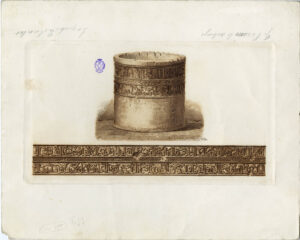
The piece, although initially located in the city’s aljama mosque[11] -precisely, during the archaeological excavations carried out in the cloister of the cathedral, located in the space of the old mosque, cisterns of the aljama were documented-, was in the convent of San Pedro Mártir when in the 19th century interest began to be shown in it and it was examined by Sixto Ramón Parro and Martín Gamero. As fate would have it, the curbstone was saved from the destruction of Arabic epigraphs in 1572 executed in Toledo by Gutiérrez Tello and was finally donated to the museum in 1872 thanks to the architect Mariano López Sánchez of the Provincial Commission of Monuments. The beauty of this element attracted the attention of several travelers passing through Toledo -from the 19th century-, who drew it and reproduced it in various media (such as prints).
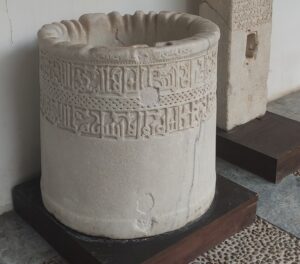
Beyond the richness of the stone used – eroded at the top by the repeated use of ropes to draw water from the well – and the quality of the inscription and its vegetal decorations, this curbstone is proof that the king’s rule did not begin on the dates indicated by various preserved written sources, 1035 or 1036 (Viguera, 1999: 57), but, at least, in 1032. It thus becomes the first testimony of al-Zafir’s rule in Tulaytula.
On the other hand, both the powerful protocol adopted by the monarch -which is linked to references only used in times of the caliphate and in relation to the caliph- and the place of the public work executed -no less than the main mosque of the city- are indications of a show of power and strength on the part of al-Zafir. The message of the king, who was neither born nor raised in Toledo -so he must have been unknown at first to his subjects-, was absolutely propagandistic and was strategically placed in the main mosque of the city, where the population congregated for Friday prayers. It was precisely from the cisterns located in the courtyard (sahn) that the Toledans would have obtained the water for ablutions. Thus, they had to find at least one of them sponsored by the monarch -and the well curbstone with the commemorative inscription-. Al-Zafir was making his presence felt in the heart of Tulaytula by providing the people with such a necessary and symbolic resource as water.
These peculiarities of the work, from my perspective, could dismiss the proposals of some researchers that the monarch had only a secondary political role and was under the influence of members of the local elites (Izquierdo Benito, 2018: 417) and support other specialists who have pointed out that he had a more prominent role, which was reflected in an intense political and military activity in his government (Delgado Valero, 1987: 39).
The second of the brocales -67 cm in height, 60 cm in diameter and 8 cm thick; also of white marble and with a commemorative inscription[12] made in a band of fluted flowery kufic-, dated by the inscription in 1037 or 1038, reports another work promoted by al-Zafir. The text[13] does not specify the specific construction, although it can be assumed that it was another cistern or well, nor its location. This has led some to propose that it also comes from the aljama mosque (Jorge de Aragoneses, 1958: 92-93), while others point out that, since the main mosque of the city is not mentioned, the work could have been executed in a secondary one (Gómez Ayllón, 2006: 141). If this last hypothesis could be confirmed, it would indicate that the presence and propaganda of the king went beyond the aljama and reached other neighborhoods of the city.
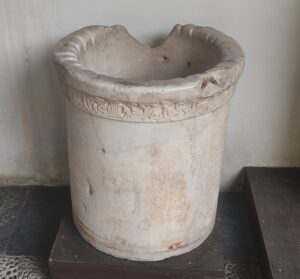
The piece was also saved from the destruction of Arabic epigraphs in 1572 in Toledo. In 1873 it was located by the architect Mariano López Sánchez in the patio of the convent of Madre de Dios in Toledo, where it was reused in an inverted position and in use, and the following year it was transferred to the museum. As in the previous one, the upper part is affected by the erosion produced by the extraction of water and even one of its parts has been fractured and lost.
In the case of the well curbstones, we are fortunate to preserve evidence of the continuity of Islamic culture in Toledo after the Christian conquest. In the “Espacio Mudéjar” (Mudejar Space), three ceramic wreaths can be seen -one with a cylindrical section and two with octagonal bodies- and a fourth one -cylindrical- is exhibited among the pieces of the Taller del Moro (Moorish Workshop). All of them are dated between the 14th and 15th centuries, which is an indication that Andalusian forms were maintained in the city for a very long period of time. The places where these parapets were located were the patios or gardens of palaces, such as Fuensalida, or of main houses, such as those in streets like San Ildefonso, Cuesta del Can or Instituto[14].
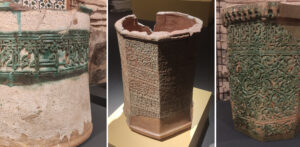
The use of the pieces, together with the reduced hardness of their materials, has caused the loss of some of their edges or bases. Nevertheless, it is still possible to appreciate both the Andalusian decorative motifs[15] (vegetal, geometric and epigraphic -in Arabic-) that were arranged -incised, carved or stamped- on ceramics executed with Islamic techniques, including glazes (white) and glazes (green) that tend to cover their outer face. The inscriptions in kufic repeat texts in search of blessing or protection: “happiness is for God”, “power is for God, glory is God’s, fortune and prosperity”, “power is for God, thanks be to God” or “prosperity”. These elements and techniques were also used by the potters of the Nasrid Granada, of which they are contemporaries. In fact, certain pieces, such as the one from Instituto Street, have been classified in studies as influenced by Granada forms.
Conclusions
The Islamic heritage, however much opposition some would like to make to it, speaks to us of cultural coexistence in the Hispanic Middle Ages. This idea is reaffirmed when one appreciates the persistence of Andalusian decorations and techniques in cities such as Toledo, conquered by the Christians in 1085, for several centuries. It can only be understood because there was an admiration and a taste for a shared culture that was characterised by the Islamic, regardless of the religions professed by these people.
The material legacy housed in our museums, such as the Santa Cruz, allows us to break with the discourses of hatred and foreignisation that have been exercised over part of what is today Spain’s cultural heritage. This is why the need to recover permanent exhibitions such as the archaeology exhibition at this Toledo institution is so crucial: they provide us with tools and arguments with which to generate new narratives that come closer to the historical realities of past societies.
We must reflect on the importance of Islamic vestiges and, specifically, those that support Arabic texts in Toledo. In 1898, after several discoveries of funerary inscriptions, including a cipher, Rodrigo Amador de los Ríos wrote in the Boletín de la Sociedad Española de Excursiones:
“It would not be difficult, if the eagerness for renewal continues in the imperial city, and if the Perhaps continues on its part to return lithological monuments of this condition, that in time a Museum of Arabic-Toledan epigraphy could be constituted in Toledo, being very regrettable when discoveries like the present one and that of 1887 take place, there is no one to prevent the immediate destruction of the sepulchral boxes, nor to hasten to draw up a meticulous plan, with which, and the knowledge of the tombs, a judgement could be formed of the funerary customs of the Toledans, and the development acquired at different times by the Muslim population of the famous Tolaitola, which reached such a high representation there during the eventful middle ages, as a consequence of the varied ethnic and social condition of its inhabitants”.
We are still waiting for both a museum of the city’s history, in which the different eras in Toledo could be explored, and a permanent exhibition or museum dedicated solely to the Islamic culture of Tulaytula and its continuities. If only we could recover Amador de los Ríos’ idea of a museum of Arabic-Toledan epigraphy.
Notes
[1] For more information on the historical development of the Santa Cruz Museum and its collections, see Caballero Klink and Gómez García, 2017.
[2] This subsidiary disappeared years later, after new uses were given to the building.
[3] This museum has remained closed since 2000.
[4] For a detailed description of this process, see, for example, Manzano Moreno, 2006: 471-503.
[5] For more details on this period of government and its members, see Viguera, 1999: 53-56. If you are interested in more information than what is presented here on the Taifa kingdoms, we recommend Viguera, 1994.
[6] In fact, a room recently opened to the public in the hospital of Santa Cruz is a visitable warehouse that has the name of “Espacio Mudéjar” (Mudejar Space).
[7] A very complete article to understand the creation of the term “Mudejar art”, its development and its problematics is Ruiz Souza, 2016.
[8] On wells and cisterns in al-Andalus, a doctoral thesis was carried out a few years ago at the Complutense University of Madrid, in which several hundred of them are collected and studied: Shawky Sayed, 2016.
[9] In Arabic, a nickname that is usually part of the names of important people.
[10] For more details on the transcription of the Arabic text, its translation and other aspects about this commemorative inscription, see Gómez Ayllón, 2006: 117-124.
[11] Extensive information on the conduct of these archaeological excavations and their results can be found in Almagro-Gorbea, 2011.
[12] In which is repeated the title of the king mentioned in the first curbstone.
[13] For more details on the transcription of the Arabic text, its translation and other aspects of this commemorative inscription, see Gómez Ayllón, 2006: 137-141.
[14] The four pieces are collected and studied in Shawky Sayed’s doctoral thesis mentioned above.
[15] Even the hamsa or hand of Fatima.
Bibliography
ALMAGRO-GORBEA, Martín (2011): Excavaciones en el claustro de la catedral de Toledo, Real Academia de la Historia, Madrid.
AMADOR DE LOS RÍOS, Rodrigo (1898): «Epigrafía arábiga. Inscripción sepulcral de un cipo, recientemente hallado en Toledo», Boletín de la Sociedad Española de Excursiones, 22-23.
JORGE ARAGONESES, Manuel (1958): Guías de los Museos de España VIII. El Museo Arqueológico de Toledo, Dirección General de Bellas Artes, Madrid.
CABALLERO KLINK, Alfonso y GÓMEZ GARCÍA, Laura María (2017): «El Museo de Santa Cruz de Toledo», Boletín del Museo Arqueológico Nacional, 35, 947-964.
CALVO CAPILLA, Susana (2011): «El arte de los reinos de taifas: tradición y ruptura», Anales de Historia del Arte, vol. extra (2): Alfonso VI y el arte de su época, 60-92.
DELGADO VALERO, Clara (1987): Toledo islámico: ciudad, arte e historia, Caja de Ahorros de Toledo, Toledo.
GÓMEZ AYLLÓN, Elisa Encarnación (2006): Inscripciones árabes de Toledo: época islámica, tesis doctoral, Universidad Complutense de Madrid, Madrid.
IZQUIERDO BENITO, Ricardo (2018): «Toledo y su taifa», Tawa’if: historia y arqueología de los reinos de taifas, Alhulia, Salobreña, 83-124.
MANZANO MORENO, Eduardo (2006): «Desmoronamiento y continuidad», Conquistadores, emires y califas. Los omeyas y la formación de al-Ándalus, Barcelona, Crítica, 471-503.
MARTOS QUESADA, Juan (2009): «Los reinos de taifas en el siglo XI», Historia de España medieval: Al-Ándalus, Itsmo, Madrid, 147-272.
RUIZ SOUZA, Juan Carlos (2016): «Los estilos nacionales y sus discursos identitarios: el denominado estilo mudéjar», en Álvaro Molina Martín (coord.), La Historia del Arte en España: devenir, discursos y propuestas, Polifemo, Madrid, 197-216.
SHAWKY SAYED, Zeinab (2016): Brocales de pozos y aljibes andalusíes y mudéjares, tesis doctoral, Universidad Complutense de Madrid, Madrid.
VIGUERA MOLINS, María Jesús (1994): «Reinos de taifas. Historia política», Historia de España de Menéndez Pidal, tomo VIII, Espasa-Calpe, Madrid.
—— (1999): «La taifa de Toledo», Entre el Califato y la taifa. Mil años del Cristo de la Luz, Asociación de Amigos del Toledo Islámico, Toledo, 53-65.


